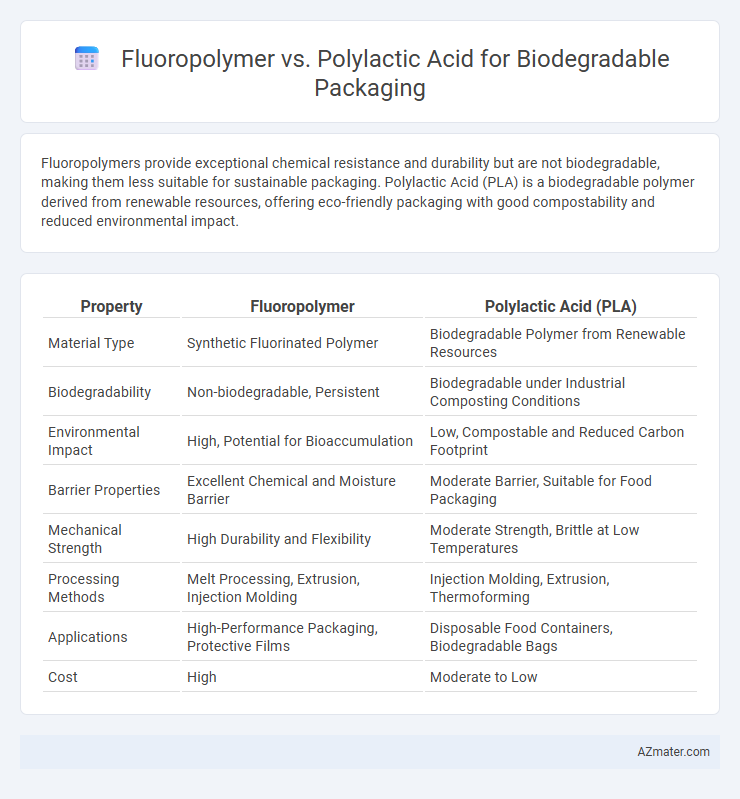Fluoropolymers provide exceptional chemical resistance and durability but are not biodegradable, making them less suitable for sustainable packaging. Polylactic Acid (PLA) is a biodegradable polymer derived from renewable resources, offering eco-friendly packaging with good compostability and reduced environmental impact.
Table of Comparison
| Property | Fluoropolymer | Polylactic Acid (PLA) |
|---|---|---|
| Material Type | Synthetic Fluorinated Polymer | Biodegradable Polymer from Renewable Resources |
| Biodegradability | Non-biodegradable, Persistent | Biodegradable under Industrial Composting Conditions |
| Environmental Impact | High, Potential for Bioaccumulation | Low, Compostable and Reduced Carbon Footprint |
| Barrier Properties | Excellent Chemical and Moisture Barrier | Moderate Barrier, Suitable for Food Packaging |
| Mechanical Strength | High Durability and Flexibility | Moderate Strength, Brittle at Low Temperatures |
| Processing Methods | Melt Processing, Extrusion, Injection Molding | Injection Molding, Extrusion, Thermoforming |
| Applications | High-Performance Packaging, Protective Films | Disposable Food Containers, Biodegradable Bags |
| Cost | High | Moderate to Low |
Introduction to Biodegradable Packaging Materials
Biodegradable packaging materials are essential in reducing environmental impact by breaking down naturally through microbial activity. Fluoropolymers offer chemical resistance and durability but lack biodegradability, posing challenges for sustainable packaging solutions. Polylactic acid (PLA), a biopolymer derived from renewable resources like corn starch, provides effective biodegradability and compostability, making it a preferred choice for eco-friendly packaging applications.
Overview of Fluoropolymers
Fluoropolymers, known for their exceptional chemical resistance and thermal stability, offer durable options for packaging but are not inherently biodegradable, posing environmental challenges. Their low surface energy and non-stick properties make them valuable in applications requiring moisture and chemical barriers, yet these properties hinder microbial degradation. Despite advancements in fluoropolymer recycling, their persistence in the environment contrasts sharply with the compostable nature of polylactic acid (PLA), positioning them differently in sustainable packaging strategies.
Polylactic Acid (PLA): Properties and Applications
Polylactic Acid (PLA) is a biodegradable thermoplastic derived from renewable resources such as corn starch or sugarcane, offering excellent compostability and a lower carbon footprint compared to traditional plastics like Fluoropolymers. PLA exhibits good mechanical properties, including transparency, tensile strength, and heat resistance up to 60degC, making it ideal for food packaging, disposable tableware, and agricultural films. Its biodegradability under industrial composting conditions and reduced environmental impact drive widespread adoption in sustainable packaging solutions.
Environmental Impact: Fluoropolymers vs PLA
Fluoropolymers, known for their chemical resistance and durability, present significant environmental challenges due to their persistence and difficulty in biodegradation, leading to long-term ecological accumulation and potential toxicity. Polylactic Acid (PLA), derived from renewable resources like corn starch, offers a more eco-friendly alternative as it biodegrades under industrial composting conditions, reducing landfill waste and greenhouse gas emissions. However, PLA's environmental benefits rely on proper waste management infrastructure, whereas the persistent nature of fluoropolymers contributes to microplastic pollution and environmental persistence.
Biodegradability Comparison: Fluoropolymers vs PLA
Polylactic Acid (PLA) demonstrates superior biodegradability compared to fluoropolymers, as PLA readily decomposes through microbial activity in industrial composting environments within months, yielding non-toxic byproducts like carbon dioxide and water. Fluoropolymers, characterized by strong carbon-fluorine bonds, exhibit exceptional chemical resistance and environmental persistence, resulting in negligible biodegradation and accumulation in ecosystems. The contrast in degradation rates makes PLA a more sustainable choice for biodegradable packaging applications aiming to minimize environmental impact and facilitate circular waste management.
Mechanical and Barrier Properties in Packaging
Fluoropolymers exhibit superior mechanical strength and exceptional barrier properties against gases, moisture, and chemicals, making them ideal for protective packaging applications. Polylactic acid (PLA) offers biodegradability and compostability but generally has lower tensile strength and inferior barrier resistance to oxygen and water vapor compared to fluoropolymers. Advanced PLA formulations and multilayer structures aim to enhance durability and barrier effectiveness, although they still typically fall short of the performance levels demonstrated by fluoropolymer-based materials.
Cost Analysis and Market Availability
Fluoropolymer packaging materials typically incur higher production costs due to complex fluorination processes and raw material expenses, limiting their widespread market availability compared to polylactic acid (PLA), which benefits from lower manufacturing costs and abundant bio-based feedstocks like corn starch. PLA dominates the biodegradable packaging market with extensive commercial accessibility and competitive pricing, making it a cost-effective choice for sustainable packaging solutions. Cost analysis favors PLA for large-scale adoption in biodegradable packaging, while fluoropolymers remain niche due to specialized applications and higher investment requirements.
Regulatory and Safety Considerations
Fluoropolymers used in packaging face stringent regulatory scrutiny due to potential environmental persistence and bioaccumulation concerns, leading to restrictions under policies like the EU's REACH and U.S. EPA guidelines. Polylactic acid (PLA) is generally recognized as safe (GRAS) by the FDA and complies with compostability standards such as ASTM D6400, making it favorable for biodegradable packaging with lower toxicological risks. The choice between fluoropolymers and PLA involves balancing regulatory compliance with environmental impact assessments, emphasizing PLA's advantage in meeting global biodegradability and food safety regulations.
Industry Adoption and Trends
Fluoropolymers see limited use in biodegradable packaging due to their persistent environmental impact, prompting a shift towards polylactic acid (PLA), which is extensively adopted for its compostability and renewable sourcing from corn starch or sugarcane. Leading packaging manufacturers integrate PLA in sustainable product lines, responding to regulatory pressures and consumer demand for eco-friendly materials. Industry trends highlight increasing investment in PLA enhancement technologies, improving barrier properties and cost-competitiveness to accelerate market penetration over fluoropolymer alternatives.
Conclusion: Choosing the Right Biodegradable Packaging Material
Fluoropolymer offers exceptional chemical resistance and durability, making it suitable for packaging requiring extended shelf life, but it lacks full biodegradability, limiting its environmental benefits. Polylactic Acid (PLA) provides a compostable and biodegradable alternative derived from renewable resources, ideal for eco-friendly packaging with shorter usage cycles. Selecting the right biodegradable packaging material depends on balancing product protection needs with environmental impact, where PLA is favorable for sustainability-focused applications and fluoropolymer suits performance-critical uses.

Infographic: Fluoropolymer vs Polylactic Acid for Biodegradable Packaging
 azmater.com
azmater.com